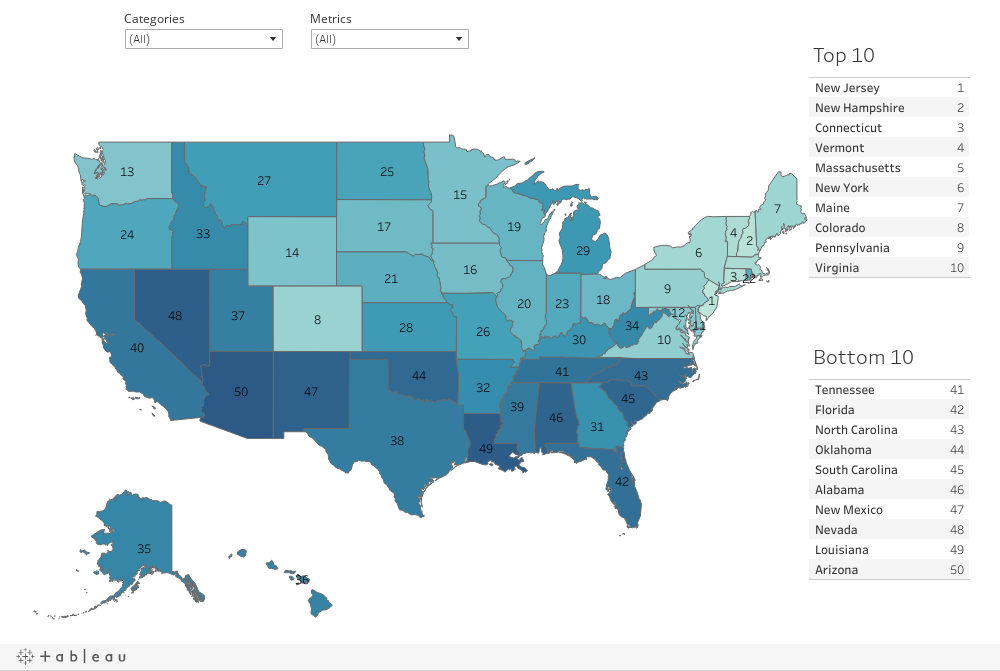This article examines Texas’s educational system and its claim to being the top-ranked state in education. By analyzing various factors, including graduation rates, standardized test scores, and educational investments, we will assess whether Texas truly deserves the title of the best-educated state. Through the examination of relevant data and comparing it with other states’ educational performance, we will provide a comprehensive evaluation of Texas’s standing in education and shed light on whether it holds the coveted top spot.
Education Rankings in the United States
Education rankings in the United States provide valuable insights into the performance and effectiveness of different states’ education systems. These rankings take into account various factors that contribute to a state’s educational outcomes, such as student achievement, graduation rates, and educational equity. Understanding the strengths and weaknesses of a state’s education system is crucial for policymakers, educators, and parents alike in their quest to provide the best education opportunities for students.
National Education Rankings
In the realm of national education rankings, Texas has had a mixed performance. While the state has made progress in certain areas, it still has room for improvement. The National Education Rankings take into consideration multiple metrics, including academic achievement, graduation rates, and access to quality education. These rankings provide a holistic view of a state’s education system and allow for comparisons across different states in the country.
Factors Considered in Education Rankings
Education rankings consider various factors when assessing the overall performance of a state’s education system. These factors typically encompass student success metrics such as standardized test scores, graduation rates, college readiness, and access to educational resources. Other essential elements include the equity of educational opportunities for all students, teacher quality and retention, as well as funding for education. By analyzing these factors, rankings aim to provide a comprehensive assessment of a state’s education system.
Texas Education System Overview
To understand Texas’ education rankings, it is essential to examine the overall structure and components of the state’s education system. From the state education agency to the K-12 and higher education systems, each element plays a crucial role in shaping the educational landscape of Texas.
State Education Agency
The Texas Education Agency (TEA) serves as the state’s primary education agency, responsible for overseeing public education from preschool through twelfth grade. TEA’s mission is to ensure that all Texas students have access to a high-quality education that prepares them for success in the workforce, college, or career. The agency collaborates with local school districts, provides educational resources and guidance, and enforces state education policies.
K-12 Education System
The K-12 education system in Texas comprises a vast network of schools, school districts, and educational institutions. The system is designed to provide students with a strong foundation in core subjects, including English language arts, mathematics, science, and social studies. It incorporates various instructional methodologies, such as traditional classroom teaching, project-based learning, and online education. Texas also offers specialized programs for students with unique needs or talents, including gifted and talented education and special education services.
Higher Education in Texas
Texas boasts a robust higher education system, with numerous universities, colleges, and vocational schools spread across the state. These institutions collectively offer a wide range of academic programs, including undergraduate and graduate degrees in various fields of study. Higher education in Texas aims to prepare students for their chosen career paths, equipping them with the necessary skills and knowledge to thrive in a dynamic and globalized society. The state’s universities are renowned for their research contributions and commitment to academic excellence.

This image is property of thumbnails.texastribune.org.
Examining Texas’ Education Rankings
By considering Texas’ education rankings at both the national and state levels, we gain a comprehensive perspective on the strengths and weaknesses of the education system in the Lone Star State. These rankings shed light on various aspects, such as student achievement, graduation rates, and educational equity.
National Rankings
When compared to other states, Texas has exhibited a mixed performance in national education rankings. While it has shown improvements in certain areas, it has also faced challenges in others. Rankings provide valuable insights into how Texas compares to other states in terms of student performance and educational outcomes. By benchmarking against the best practices of high-performing education systems, Texas can identify areas for improvement and implement strategies to enhance the quality of education across the state.
How Texas Ranks in Education
Texas’ education rankings are influenced by various factors, including student achievement, graduation rates, and access to quality education. While the state has made progress in these areas, there is still work to be done to ensure that all students receive an excellent education. Efforts to improve student outcomes should include addressing achievement gaps, investing in teacher quality and retention, and ensuring equitable funding for schools. By focusing on these key areas, Texas can continue to make strides in education rankings.
Critical Analysis of Rankings
While rankings provide valuable insights, it is essential to critically analyze and interpret the data. Rankings are based on specific metrics, and different rankings may prioritize different factors. Therefore, it is crucial to consider the methodology and context behind each ranking system. By critically analyzing rankings, policymakers and educators can gain a nuanced understanding of the strengths and weaknesses of Texas’ education system and develop targeted strategies for improvement.
Strengths of the Texas Education System
Recognizing the strengths of the Texas education system is crucial in shaping future reforms and initiatives. Texas has several notable strengths in areas such as education funding, college and career readiness, career and technical education programs, and student performance improvement.
Texas Education Funding
Texas has made significant investments in education funding, aiming to ensure that schools have the necessary resources to support student learning and success. The state’s commitment to funding education has allowed for improvements in areas such as teacher salaries, technology integration, and the availability of instructional materials. Adequate funding plays a pivotal role in providing students with access to quality education and creating an environment that fosters academic achievement.
College and Career Readiness
Preparing students for college and careers is a fundamental objective of the Texas education system. The state has implemented initiatives and programs to enhance college and career readiness, enabling graduates to successfully transition from high school to post-secondary education or the workforce. Through rigorous coursework, career counseling, and partnerships with industry professionals, Texas equips students with the skills and knowledge necessary to thrive in higher education and the job market.
Career and Technical Education (CTE) Programs
Texas also excels in offering robust career and technical education (CTE) programs, allowing students to gain specialized skills and knowledge in various fields. CTE programs provide students with hands-on learning opportunities, preparing them for careers in sectors such as healthcare, technology, skilled trades, and business. By integrating academic and technical instruction, Texas’ CTE programs equip students with the competencies needed for both college and career success.
Student Performance Improvement
Texas has shown progress in improving student performance and narrowing achievement gaps. By implementing evidence-based instructional strategies and providing targeted interventions for struggling students, the state has witnessed positive outcomes in terms of academic achievement. Enhanced curriculum standards, rigorous assessments, and data-driven decision-making have contributed to these improvements, ensuring that students receive a high-quality education that prepares them for future success.

This image is property of public.tableau.com.
Challenges and Areas for Improvement
While Texas has numerous strengths in its education system, it also faces a range of challenges that require attention and targeted interventions. Some of the key areas for improvement include education equity and achievement gaps, teacher quality and retention, and educational funding disparities.
Education Equity and Achievement Gaps
Ensuring educational equity and closing achievement gaps is a critical challenge for Texas. Despite progress, disparities still exist among different student populations, including economically disadvantaged students, students of color, and English learners. To address these gaps, Texas must focus on providing targeted support, interventions, and resources to students who face the greatest barriers to success. By prioritizing equity and implementing evidence-based practices, the state can strive towards eliminating achievement gaps and ensuring that every student has an equal opportunity to thrive academically.
Teacher Quality and Retention
Maintaining a high-quality teaching force and addressing teacher retention challenges are vital for the long-term success of Texas’ education system. Recruiting and retaining skilled educators is crucial for providing students with strong instructional support and fostering a positive learning environment. Texas must invest in competitive compensation packages, professional development opportunities, and supportive working conditions to attract and retain highly qualified teachers. By prioritizing teacher quality, the state can ensure continued educational growth and improvement.
Educational Funding Disparities
Despite significant investments in education funding, Texas faces disparities in educational funding across districts. These disparities contribute to inequities in available resources and opportunities for students. Addressing funding disparities requires a comprehensive approach that includes restructuring funding formulas, enhancing equity in property tax allocations, and allocating resources based on student and district needs. By closing the funding gaps, Texas can ensure that all students receive an equitable and high-quality education, regardless of their ZIP code.
Initiatives and Reforms in Texas Education
Recognizing the need for continuous improvement, Texas has initiated various reforms and initiatives aimed at enhancing the quality of education. These efforts encompass areas such as education reform strategies, preparation for the future workforce, and technology integration in education.
Texas Education Reform Efforts
Texas has been proactive in implementing education reform strategies that prioritize student achievement, such as enhanced curriculum standards and accountability measures. The state has established rigorous academic standards, known as the Texas Essential Knowledge and Skills (TEKS), to ensure that students are equipped with the necessary skills and knowledge for success. Additionally, Texas has implemented a comprehensive accountability system that holds schools and districts accountable for student performance and progress.
Preparation for Future Workforce
In response to the evolving demands of the workforce, Texas has placed a strong emphasis on career readiness and preparation. The state has fostered partnerships between educational institutions and industry leaders to ensure that curriculum aligns with industry needs. By offering coursework and certifications in high-demand fields, Texas prepares students for the job market and equips them with the skills necessary for success.
Technology Integration in Education
Recognizing the transformative power of technology, Texas has made efforts to integrate technology into classrooms and enhance digital literacy. The state has invested in educational technology infrastructure, teacher training, and digital resources to support student learning. By leveraging technology, Texas aims to provide students with engaging and personalized learning experiences that prepare them for the digital age.

This image is property of www.ktsm.com.
The Role of Standardized Testing
Standardized testing, such as the State of Texas Assessments of Academic Readiness (STAAR), plays a significant role in the Texas education system. Standardized tests provide a measure of student achievement and serve as a tool to assess the effectiveness of instructional practices and curriculum standards. However, the role of standardized testing is not without criticism.
STAAR Testing in Texas
The State of Texas Assessments of Academic Readiness (STAAR) is the primary standardized testing program used in Texas. It assesses students’ knowledge and skills in core subjects, providing data for instructional planning and accountability purposes. STAAR tests are administered annually to students in various grade levels to evaluate their academic progress. Results from these tests play a role in decision-making processes, including promotion to the next grade level and school ratings.
Criticism of Standardized Testing
While standardized testing provides valuable data, it has also faced criticism. One common critique is that high-stakes testing leads to a narrow focus on test preparation, potentially limiting the breadth and depth of the curriculum. Critics argue that excessive testing can create undue stress for students and may not accurately measure the full range of student abilities or learning outcomes. Striking a balance between the benefits and drawbacks of standardized testing is crucial to ensure that assessments effectively inform instruction without overburdening students and educators.
Impacts of COVID-19 on Texas Education
The COVID-19 pandemic has disrupted education systems globally, and Texas is no exception. The transition to remote learning, learning loss, and the mental health and well-being of students have become significant areas of concern.
Transition to Remote Learning
The pandemic necessitated a rapid shift to remote learning for many Texas students. Schools had to quickly adapt to online platforms and virtual instruction. This transition presented challenges such as access to technology and internet connectivity for all students, particularly those from low-income families or rural areas. Educators had to navigate the complexities of delivering effective instruction in a virtual format.
Learning Loss and Achievement Gap
Extended periods of remote learning and disruptions to traditional instructional models have led to concerns about learning loss and the widening of the achievement gap. The pandemic has impacted students’ educational progress, particularly for those who faced additional barriers to learning during remote instruction. Addressing learning loss and providing targeted interventions will be crucial in mitigating the long-term effects of the pandemic on student achievement.
Mental Health and Well-being of Students
The pandemic has also highlighted the importance of addressing the mental health and well-being of students. The uncertainty and stress caused by the pandemic have taken a toll on students’ mental health. Schools and districts must prioritize mental health support services and resources to ensure that students have the necessary supports and interventions to navigate these challenging times.

This image is property of mma.prnewswire.com.
Case Studies: High-Performing School Districts
Examining high-performing school districts within Texas provides valuable insights into exemplary education practices and strategies that contribute to success.
Identifying High-Performing School Districts
High-performing school districts are characterized by strong student outcomes, innovative instructional practices, and effective leadership. These districts consistently achieve high levels of student achievement and demonstrate comprehensive approaches to education. By analyzing the practices and strategies employed by these districts, Texas can identify best practices that can be replicated to enhance education across the state.
Exemplary Education Practices in Texas
Several high-performing school districts in Texas serve as models for educational excellence. These districts focus on areas such as data-driven decision-making, strong community engagement, well-rounded education, and comprehensive support systems for students. By studying the practices and strategies employed by these districts, Texas can learn valuable lessons and incorporate effective approaches into statewide initiatives to improve educational outcomes further.
Conclusion
While Texas has made progress in its education system, there is still work to be done to ensure that all students have access to a high-quality education. Examining the strengths and weaknesses, implementing targeted reforms, and addressing critical challenges are key components of improving education in the Lone Star State. By prioritizing teacher quality, educational equity, and comprehensive student support, Texas can continue to strive for excellence and provide a solid foundation for its students’ future success. With a commitment to continuous improvement and the implementation of evidence-based practices, the future prospects for Texas’ education system look promising.

This image is property of imageio.forbes.com.
